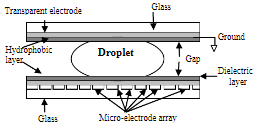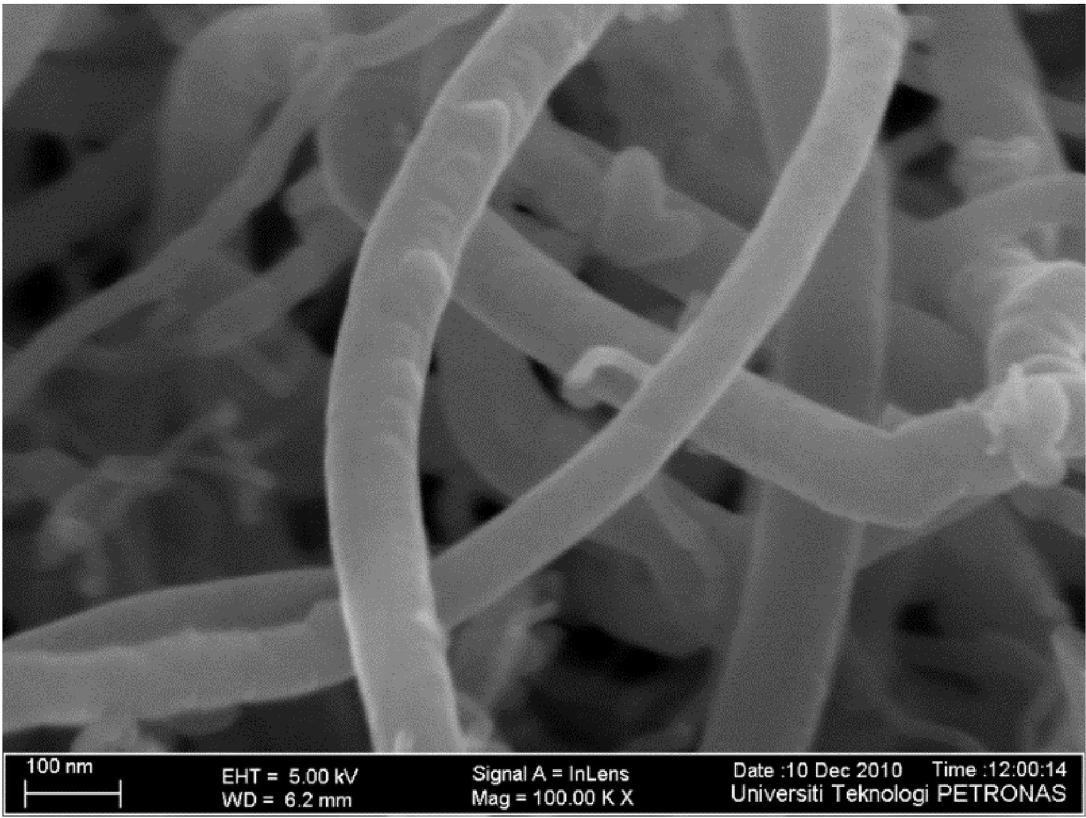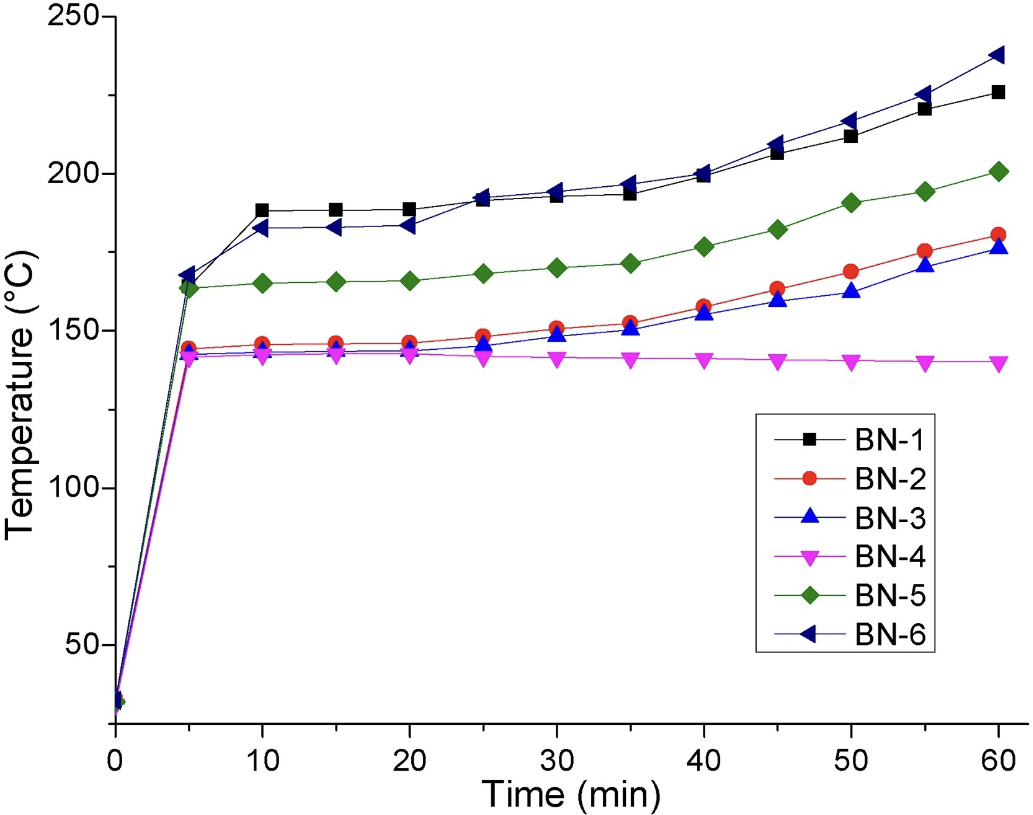Effects of nano-sized boron nitride on thermal decomposition and water resistance behaviour of epoxy-based intumescent coating
Author: Faiz Ahmad - June 2018
Eza S.B. Zulkurnain, Sami Ullah, Norlaili Amir
Abstract
In present research work, the effect of nano-sized boron nitride (BN) was studied on intumescent fire retardant coating (IFRC) for structural application. The coated steel substrates were subjected to furnace fire test at 800 °C for 2 h and fire protection test for 1 h. The coatings were characterized by Thermogravimetric analysis (TGA) while the char from fire test was characterized by field emission scanning electron microscopy (FESEM), X-ray diffraction (XRD), Fourier transform infrared spectroscopy (FT-IR) and X-ray photoelectron spectroscopy (XPS). Furnace fire test showed that IFRC reinforced with 4 mass% of nano-sized BN expanded more than 54.84% compared to the BN-1 formulation. Fire protection test performed for 1 h showed minimum substrate temperature of 140 °C with 4 mass% of BN which proved that the IFRC can successfully protect steel substrates within its critical temperature. A maximum of 44.49% residual mass was also recorded for the same coating. XRD analysis revealed that the remaining char contained boron phosphate, boron nitride and phosphoric nitride which are stable at high temperature. The presence of these compounds was also confirmed by functional group analysis using FTIR. FESEM confirmed that micrograph of char contained hexagonal BN. XPS analysis showed a fraction decrease in carbon contents of char residues of intumescent coating formulations with the increase of BN quantity. Pyrolysis GC-MS confirmed that formulations BN-4 released less gaseous product concentration compared to BN-1. Water immersion test showed that there was no trend of mass gain percentage with increasing amount of nano-sized boron nitride incorporated into the coating. The mass gain remained between 1.74% to 2.82%. Overall concluded that the formulation with 4 mass% BN effectively promoted the amount of char acted as a passive protective layer to the substrate resulting in lower substrate temperature with higher coating residual mass.
Methodology
Carbon steel was used as a substrate in this study. There were three main materials used in the coating: ammonium polyphosphate (APP) as an acid source, melamine as blowing agent and expandable graphite (EG) as a carbon source. EG was obtained from Kaiyu Industrial (HK) Ltd., China. The APP was purchased from Clariant (Malaysia) Sdn. Bhd., Malaysia under product name of Exolit ® AP 422. Melamine and boric acid were purchased from Sigma-Aldrich (M) Sdn. Bhd., Malaysia. Besides that, other materials were also used namely: Bisphenol A was purchased from Chang Chun Plastics Co. Ltd, ACR hardener H-2310 was purchased from ACR Tech Co Ltd. In this study, boron nitride was supplied by Xuzhou Jiechuang New Material Technology Co., Ltd., China. The FESEM image of boron nitride is presented in Fig. 1.
Impact & Benefits
Enhanced Fire Protection: The coatings prevent structural steel from reaching critical failure temperatures, ensuring the integrity of load-bearing elements during a fire.
Cost Efficiency: The use of intumescent coatings is highlighted as a cost-effective method compared to other fire protection measures. They can be applied to various materials, including metals, polymers, textiles, and wood.
Maintaining Structural Integrity: The article emphasizes that these coatings do not modify the intrinsic properties of the coated substrates. This ensures that the materials retain their original strength and characteristics while being protected from fire.
Synergistic Effects of Fillers: Adding fillers to the intumescent system enhances the flame retardant properties significantly. The article details how inorganic fillers like multi-walled carbon nanotubes (MWCNTs) and boron nitride improve the durability, thermal stability, and fire retardancy of the coatings.
Innovative Research and Development:Findings such as the highest residual mass, improved thermal properties, and reduced gas emissions during decomposition highlight the innovative advancements in fire retardant coatings.
Findings/Figures and Research Data
The coated steel plates underwent fire protection test and the substrate temperature versus time curves were illustrated in Fig. 3. Figure represented the physical appearances of the coating after 60 min of fire protection test. The final substrate backside temperature of BN-1, BN-2, BN-3, BN-4, BN-5, and BN-6 was 225.8 °C, 180.4 °C, 176.2 °C, 140.2 °C, 200.7 °C and 237.8 °C after 60 min respectively. Formulation BN-4 had the lowest final substrate temperature for this test. Fig. 4 showed a better char surface with little char oxidation area and no char cracking of BN-3 and BN-4 compared to BN-1, BN-2, BN-5, and BN-6. The substrate temperature of BN-3 and BN-4 formulation reached 148 °C and 145 °C after 30 min and 162 °C and 138 °C after 60 min. This substrate temperature is significantly lesser than BN-1, BN-2, BN-5, and BN-6 after 60 min. BN-1, BN-2, BN-5 and BN-6 formulation after fire protection test showed cracks, holes, and oxidation of char as indicated by the arrow.
Market Potential
Wide Application Scope: Structural steel in buildings, bridges, and offshore structures requires fire protection to ensure safety and compliance with regulations. Intumescent coatings offer effective solutions without compromising structural integrity.
Increasing Demand for Effective Fire Protection:Industries are increasingly adopting fire-resistant materials to mitigate risks associated with fire hazards, enhancing the market prospects for advanced coatings.
Cost Efficiency and Performance:Intumescent coatings are highlighted as cost-efficient compared to traditional fire protection methods. Their ability to maintain material properties while enhancing fire resistance makes them economically viable for widespread adoption.
Technological Advancements and Innovation:Ongoing research into novel fillers and optimized formulations, such as nano-sized boron nitride, demonstrates a commitment to enhancing performance and expanding application possibilities.
Regulatory Compliance and Safety Standards:Stringent regulatory requirements worldwide mandate fire safety measures in construction and industrial sectors. Intumescent coatings that meet or exceed these standards are poised for significant market uptake.



